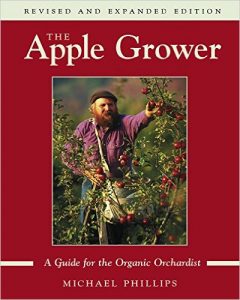 “The Apple Grower” is an excellent book, but not one for the casual apple grower. That doesn’t mean that another, simpler book would be better for the casual apple grower. Rather, it appears to me (very much a non-expert) that apple growing isn’t possible to do casually, so “casual apple grower” is a very small group, consisting of those who pick a few apples of varying quality from their trees and let the rest drop. So, if you’re like me, and planning on planting and maintaining ten or twenty apple trees for my family’s own personal use, this book shows you very well how to do that. But it doesn’t make it sound easy.
“The Apple Grower” is an excellent book, but not one for the casual apple grower. That doesn’t mean that another, simpler book would be better for the casual apple grower. Rather, it appears to me (very much a non-expert) that apple growing isn’t possible to do casually, so “casual apple grower” is a very small group, consisting of those who pick a few apples of varying quality from their trees and let the rest drop. So, if you’re like me, and planning on planting and maintaining ten or twenty apple trees for my family’s own personal use, this book shows you very well how to do that. But it doesn’t make it sound easy.
Phillips pitches primarily to an audience who are small scale organic apple producers for profit. To make a profit, you have to have saleable apples in large quantity, which means fairly large, flavorful, and not damaged (unless you are making cider, a topic Phillips covers, but not in detail). To achieve that with organic methods, rather than with frequent spraying of organophosphate pesticides, requires constant attention and work, all of which Phillips covers very well. But reading “The Apple Grower,” I conclude that someone like me can do a lot less work, and accept a much higher rate of attrition from pests, yet obtain a plentiful supply of apples for eating, cooking and cider. That still means a lot of work, though, if for no other reason than to damp down the amount of insect and other pests attracted by apples. However, I don’t think readers like me should therefore be discouraged from growing apples with a disciplined organic approach, even if it’s not as easy as setting out some plants, relaxing, and harvesting.
Phillips covers siting an orchard in detail, and also discusses briefly other fruit trees in the context of a mixed-fruit orchard. He discusses, throughout the book, how to enrich the soil—his approach, as seems current among organic devotees, is a permaculture approach, viewing the local ecosystem, from fungi to predators, as a coherent whole. So, for example, he discusses at length whether mown grass, unmown grass, or tilled cover crops make the most sense for directly underneath and between trees. Phillips also discusses cultivar selection, noting that ultimately small changes in geography can make different cultivars desirable, and also that what you want out of the apples dictates which cultivars you choose. Occasionally, he assumes the reader will have equipment available that a casual apple grower is unlikely to have, such as a tractor to till—but the small-scale, not-for-profit grower can doubtless figure out how to accomplish necessary tasks without such equipment. Throughout the book Phillips has interesting sidebars, which (unlike in some other books) are not filler, but add detail or color to topics he’s covering. Some of the most interesting of these concern apple advice from earlier times—the early 20th Century or the 19th Century, and how much of that advice is still valid (and was often forgotten in the days when chemical sprays became the norm).
“The Apple Grower” discusses care of trees, from planting to pruning, and spends a lot of time on apple pests and their (organic) control. Phillips is particularly enamored of a new kaolin spray called “Surround”—so much so that it’s either extremely good or he owns stock in the company! Finally, Phillips discusses harvesting and marketing apples. All of this is well written and seems to have the appropriate level of detail. Yes, every so often Phillips gets a bit touchy-feely, with occasional odd mentions of the astral theories of plant life of some guy named Rudolf Steiner. But that probably just proves how close to his subject matter he is, and is a recommendation, not a criticism.
